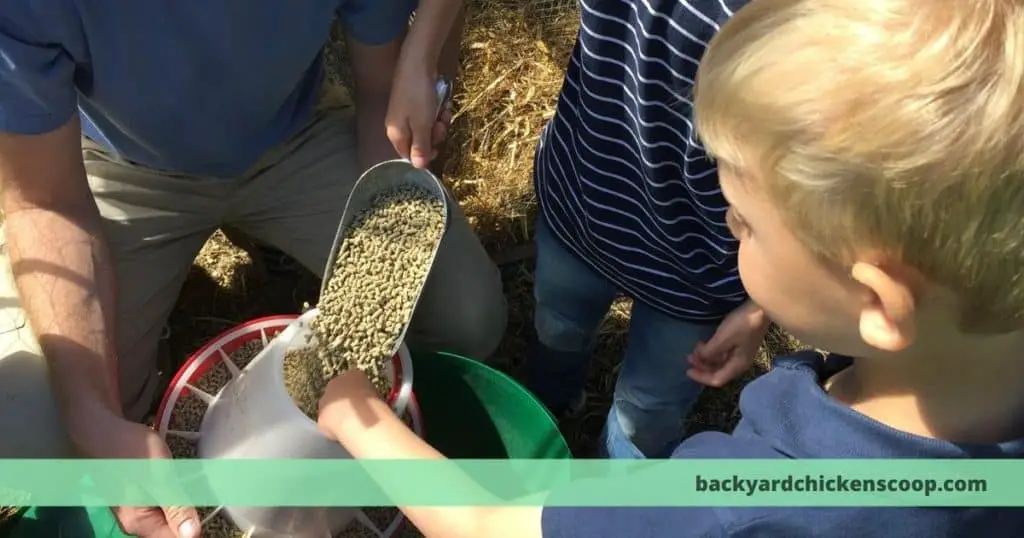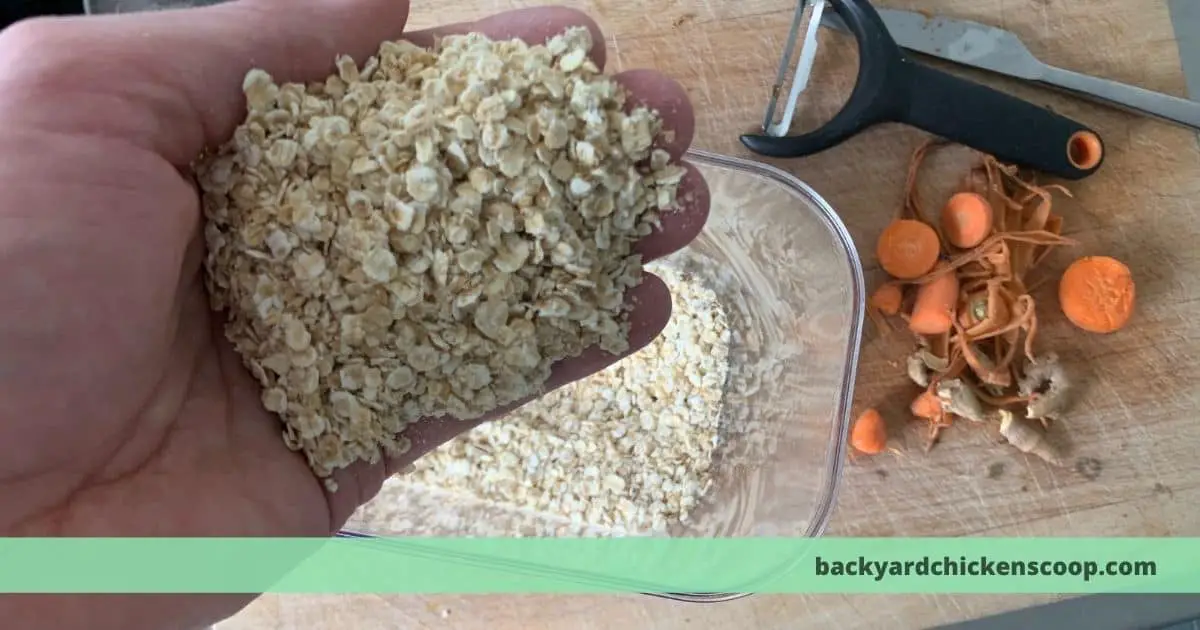During moulting season, high-protein, healthful food can aid your chickens. Shrimp shells, intestines, as well as lobster shells, as well as lobster but also shrimp meat, can be fed to your hens raw or cooked. Chickens go crazy for dried mealworms or grubs, which are one of the greatest protein sources available.
Below are ten super chicken protein sources for feed as our veterinarian recommends them.
Here’s a concise table that outlines some of the best high-protein food options:
| High-Protein Food | Protein Content (Approximate) | Notes |
|---|---|---|
| Soybean Meal | 40-45% | A very common protein supplement in poultry diets, rich in amino acids. |
| Fish Meal | 60-70% | High in protein and essential omega-3 fatty acids, but use should be moderate to avoid flavor issues in eggs or meat. |
| Meat and Bone Meal | 50-60% | Good source of protein and minerals, but its use depends on regulations due to disease transmission risks. |
| Alfalfa Meal | 17-20% | High in protein and essential omega-3 fatty acids, but use should be moderate to avoid flavour issues in eggs or meat. |
| Peas | 20-25% | Not only a protein source but also rich in fibre and minerals, good for foraging. |
| Lentils | 25-30% | Can be used whole or ground as a protein source; also provides dietary fibre. |
| Sunflower Seeds | 16-20% | High in protein and fats, should be fed in moderation. |
| Earthworms | 60-70% | Excellent source of protein and other nutrients; can be raised at home or purchased. |
| Crickets | 60-70% | Another live feed option, high in protein and fat, is loved by chickens. |
| Mealworms | 50-55% | Another legume option, is high in protein and easily digestible for chickens. |
1. Cooked Eggs Comprise 91% Protein
Eggs are the ideal complete food. However, you just shouldn’t feed them uncooked eggs because they might decide to get a snack all by themselves. The final thing you would like for your hens to devour your nice fresh eggs. In any case, raw eggs provide less protein as compared to cooked eggs (around 51 per cent).
Cooked eggs, on the other hand, are fine; chickens would not recognise them as eggs since it has texture and smell. Scrambled eggs also are tasty, but don’t make them with milk since chickens can’t digest them. Also, don’t add any salt because they don’t require it in the amounts we do.
2. Fish Or Fish Meal Comprises of 61 – 72% Protein
Due to their high quantities of Omega 3 oils, sardines and tuna were particularly healthy, although any oily fish is healthy. Chickens adore sardines, a high-protein fish. Do not even worry about either the bones; they’ll consume the tiniest ones but leave the larger ones alone. When you feed anything like a whole herring and mackerel, the head plus skeleton are all that’s remaining. They scavenge the rest.
In warmer weather, fish could be handy and provide them to hens like a rare summer treat. Make use of fish in water with sunflower oil without any added ingredients, especially salt. Of fact, fish meal is treated and contains chemicals to stabilize it, however, it is a high-protein choice.
3. Pumpkin Seeds Comprised Of 31 – 33% Protein
Pumpkin seeds are amongst the best high-protein feeds available to your flock. Organic seeds should be used instead than packaged seeds, which are sometimes heavy in salt. After a couple of days, they shed their freshness and a few of their nutritious content, so don’t try to stockpile them. You may either feed them right out from the pumpkin to your birds or softly toast them.
Even better, they’re high in antioxidants, which may aid your hens in their fight against sickness. They don’t kill parasites or cure infections though.
4. Mealworms Comprised Of 53% Protein Dried And About 30% Live
Mealworms are high-protein food that chickens like eating. They’re a great technique to get your flock to scratch and forage if you scatter them over the run. They’re a crunchy delicacy that your flock will adore whether added to a delicious mushy chicken porridge or perhaps a pumpkin cake. But don’t go crazy with them. A bunch of times per week gives a few to each fowl.
Do you worry if it’s illegal to feed chickens mealworms you can get the complete story here…
5. Sprouted Lentils Comprised Of 26 – 30% Protein
One of my all-time favourite delights is sprouting lentils, which I use all year. They’re one of the best high-protein foods on the market, and they’re also low in fat. My chickens don’t appreciate them as much as some of these other high-protein treats, but they’ll eat them anyhow because they’re cheap and quick to make.
6. Cat Food Comprises 26 – 30% Protein
Food for cats in a tin. Anybody who’s ever witnessed hens battling more than a lizard or frog can attest to the fact that they aren’t vegetarians. They devour both plants and animals, making them omnivores. They also enjoy beef. Cat food, whether dry kibble or canned meat, is a contentious chicken food.
Several swear by it, while others warn that this should not be used close to a chicken coop. It, like many other high-protein foods, ought not to be consumed regularly, but rather as a rare treat.
7. Sunflower Seeds Comprises 26% Protein
Sunflower seeds are strewn onto the sacking. Sunflower seeds, which are rich in proteins and would always fresh in the autumn, are however abundant in disease-fighting polyphenols. Sow sunflower seeds in the Spring and allow your flock to serve themselves to the heads whenever they’re ready, or sprinkle them dry in your run, include them in a treated block, or, finest of all, sow sunflower seeds in the Springs and then allow your flock to serve themselves to the heads once they’re ripe.
8. Garden Peas Comprises 23% Protein
For millennia, peas have already been fed to chickens, either those deemed “unfit for human eating” due to their form or size or those bred specifically for animal feed. They’re simple to grow and can be served with other vegetables or blended into a treat block. It’s best to be used as frozen peas. They’re frozen so fast that they may contain greater nutrients than any of those offered in stores as ‘fresh.’
9. Parsley Comprises 21% Protein
The parsley is a powerful immunity booster for chickens. It is often utilized as a flavouring or a garnish for curries, sauces and so on. Parsley is a herb rich in essential minerals and vitamins along with a lot of protein. This flat-leaved Italian strain particularly is a rich source of anti-carcinogen calcium and of course, protein. It is also a lower amount of fat as well.
10. Oats Comprised Of 10 – 17% Protein
Even though oats just aren’t as rich in proteins as other foods, oats are particularly useful in a variety of recipes for adding bulk and binding together diverse ingredients.
They contain calcium, soluble fibre and iron, in addition to protein.
These birds won’t consume them in large quantities, but they’re essential as part of a well-balanced diet. Avoid the ‘quick’ type, which is processed and hence contains fewer nutrients as well as more salt and sugar. Choose whole oats as well as organic oats whenever possible.
Soaking oats in water before feeding them for your chickens; renders them simpler to digest, and it’s a wonderful method to maintain them hydrated during hot summer months or even during the winter, whenever water can freeze.
11. Shrimp Shells and Lobster Shells Comprise of 30-50% Protein (Varies)
Shrimp and lobster shells are excellent sources of chitin, a type of fibre that can aid in controlling internal parasites in chickens. While the exact protein content can vary widely based on the preparation and specific type of shellfish, they generally offer a good protein boost. These shells can be fed to your chickens either raw or cooked. However, ensure they are crushed or ground to aid in digestion. It’s a novel way to recycle kitchen scraps while enriching your chickens’ diet.
12. Shrimp and Lobster Meat Comprises of 20-25% Protein
Shrimp and lobster meat, aside from being a delicacy for humans, can also be a luxurious treat for your chickens. This meat is packed with high-quality protein and essential amino acids necessary for feather regrowth during the moulting season and overall health. You can feed this to your chickens raw or cooked, but ensure no spices or harmful ingredients are added. This protein source is particularly useful during the moulting season or when your chickens need an extra protein boost.
13. Intestines (Varies by Source) Approximate Protein Content: 15-20%
Intestines from fish or other animals, properly cleaned and prepared, can be a valuable protein source for chickens. The protein content can vary depending on the animal source but generally falls within a range that can significantly benefit chickens, especially during periods of high protein demand such as growth, egg-laying, or moulting. When feeding intestines or any animal by-products, it’s crucial to ensure they come from safe, disease-free sources to avoid transmitting any illnesses to your flock.
How Much Protein Does A Chicken Need?
What is good protein for chickens? Give no over than a few handfuls of food to roughly 12 birds 2 times a week. Pullets from 7 to 18 weeks should be fed a protein content of 17 to 18 per cent.
Hens require roughly 16 per cent protein following 19 weeks of age which is all through their egg-laying cycle. When hens or chickens begin moulting, they can be provided with a higher percentage of dietary protein (as much as 20%) as well as less calcium.
Can You Feed Chickens Too Much Protein?
All proteins aren’t created equal. Protein requirements change over time, based on age and level of activity. Young pullets as well as growing chicks might require more protein, unlike adult laying hens. Younger birds are expanding in size, muscle, as well as organs, necessitating additional protein for the growth of such systems.
The protein demand of these birds will decline as they age and the body shifts from producing tissues to maintaining them. That’s why chick feed will have more protein and laying hen feeding will have lesser protein. The body could only absorb a certain amount of protein at a given moment, and it cannot keep the rest; the rest is ejected as waste, and then that waste is useless.

Protein metabolism produces a pungent ammonia odour; the sharper the odour, the more ammonia and wasted protein there is. Ammonia could cause a variety of health problems, including respiratory distress as well as eye as well as trachea impairment.
Extra protein might cause a rise in water consumption, resulting in wetter litter as well as bedding regions. Blisters as well as burns on the feet and skin can result from too much moisture inside the litter. If you utilise your bedding material as fertiliser, the extra nitrogen exhaled can cause major problems, including “burning” your plants but also damaging your garden.
Do Chickens Need Protein To Lay Eggs?
We understand that chickens require a huge amount of protein and calcium to produce a lot of eggs, therefore supplementing their diet can assist them to maintain their overall health. While the majority of your hen’s nutritional needs will be fulfilled by their usual layers pellets, a special treat now and again will help them lay more eggs!
The appropriate protein level in your feed is crucial for growing a healthy flock, so commercial rations are undoubtedly the most convenient way to have the proper amount of nutrition for the birds.
Depending on age, the best protein for producing breeds
Chick starter, grower, layer, and other terms may be used to describe these various formulas. Chicks require a huge amount of protein as they are rapidly growing and developing their feathers! The chicken Pullets require less as they’ve already passed through the quickest growth period and have developed their feathers.
Layering may require significantly more since, although having finished developing, they have begun laying eggs, which necessitates a high-protein diet.
Do Chickens Need More Protein In The Winter?
A chicken’s food preferences vary in the winter as they moult and adapt to colder weather and short, darker days. If you have a farm/ranch or even a home coop, your hens require additional nutrition in the winter. They will use a lot of energy to keep warm, therefore they should eat extra feed to compensate.
From November through March, it’s critical to feed the flock a high-quality, higher-protein diet.
Extra protein keeps the chickens warm during the winter, enhances their well-being, and maintains their body composition. In addition, hens consume to meet their daily dietary needs.
The chickens will eat less overall feed when you provide them with a higher protein, nutritionally complete diet. Your flock will have more options to collect treats if they aren’t eating as much food, and you won’t have to purchase as much.
Do Chickens Need More Protein During Moulting Season?
Usually, you would give your chickens a high-protein diet containing about 16 per cent protein. Consider adjusting the feed to an even formula with higher protein content, at least 18 per cent, during moulting season. Whenever hens cease laying, they will require less calcium, and they’ll still require some. Provide a high-protein, whole feed so you will not have to bother about adding any additional protein supplements.
Make free-choice feed available. Throughout moult, keep scratch at 10% of the feed to avoid diluting the protein level of the feed. It needs a lot of work to moult as well as develop fresh feathers. Because feathers comprise 85 per cent protein, make sure your chickens’ diet consists of a high-protein, high-nutrient feed with at least 16 per cent protein. Whether you’re feeding either of these meals, you won’t need to add any drugs or vitamins.
The chickens will moult in various ways, just as they have various personalities. Some birds lose a few feathers and regrow them in as little as three to four weeks. Several chickens miss a bunch of feathers and it takes approximately 12-16 weeks to regrow.
What Exactly Is Moulting?
Chickens shed their feathers and then regrow new ones throughout the moulting season. Our chickens consume a lot of protein to repair their gorgeous plumage as feathers have a protein-rich profile. As a result, egg production usually decreases or ceases entirely at this time.
Whenever the daylight hours start to diminish, moulting usually starts in late summer or fall. It could last anywhere between a month to 4 months, depending on the breed, genetics, as well as well-being of the chicken.
Conclusion
Your yard as well as chicken coops get strewn with feathers every year as summer goes into fall. It’s crucial to remember that hens don’t generally require a huge amount of high-protein diets, and also that overfeeding protein might harm them.
Augmenting your flock’s diet shouldn’t be essential if you’re feeding them high-quality food, especially if they’re allowed to roam freely. These meals can only be given whenever there is a definite need for them, and only in little amounts at other times.
REFERENCES

Soren, a lifelong chicken enthusiast, shares his passion and expertise through BackyardChickenScoop.com. Raising chickens since childhood, he now teaches his two sons about care, life, and food origins.
Read more about us here…

